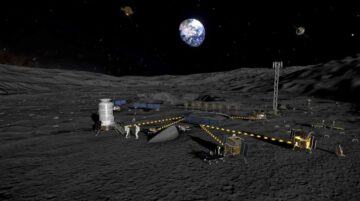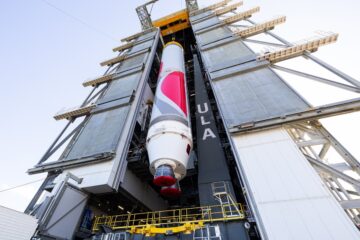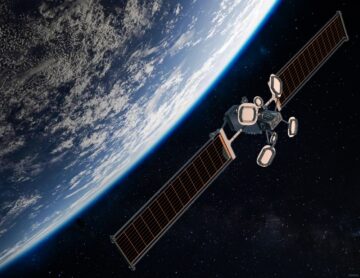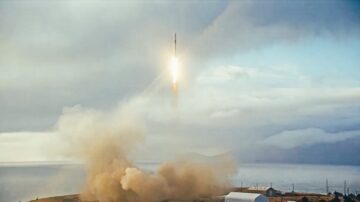WASHINGTON — The U.S. Space Force Victus Nox mission that Firefly Aerospace launched Sept. 14 set a new record for how quickly a national security payload can be put on orbit, officials said Sept. 26.
The payload, a Millennium Space small satellite, was operational 37 hours after launch. Leading up to the launch, the companies were able to integrate the payload and get ready for liftoff within a 58-hour period. Firefly was given 24-hours’ notice to launch. The previous record for a rapid-response mission, set in 2021, was 21 days.
The intent of the mission was to demonstrate that if the United States suspected that one of the nation’s spacecraft in orbit had been targeted by an adversary, it could quickly deploy an imaging satellite to identify and characterize the threat.
‘Set a high bar’
Victus Nox “set the bar really high,” Maj. Jason Altenhofen, deputy branch chief of the Space Safari office, said during a teleconference with reporters.
Space Safari oversees the military’s tactically responsive space program, which is focused on “capabilities to rapidly respond to any kind of on-orbit needs on operationally relevant timelines,” said Lt. Col. MacKenzie Birchenough, Space Safari materiel leader.
“It’s going to be very difficult to top Victus Nox,” Altenhofen said, “but we want to continue to push the commercial industry as hard as we can,” he added. “We need to leverage the competition, the commercial base as much as possible.”
Lt. Col. Justin Beltz, head of the Space Systems Command’s small launch office, said the contractors and government agencies that participated in this mission had to move at a pace that previously would have been unimaginable.
“A variety of industry and government processes were totally turned upside down in order to enable this kind of speed,” said Beltz. That included the Space Launch Delta 30 at the launch site at Vandenberg Space Force Base, the Naval Air Warfare Center, the Federal Aviation Administration and others.
More missions planned
Birchenough said the Space Force intends to “roll all of the lessons learned from Victus Nox into our next demonstration,” a mission named Victus Haze which is being planned with the Defense Innovation Unit. Industry bids for that mission were due Sept. 7.
The Space Force technology arm known as SpaceWERX separately is sponsoring a Tactically Responsive Space Challenge where companies can compete for small business innovation research awards. Altenhofen said these projects help “send a demand signal.”
What the long-term future holds for the responsive launch program depends on funding. “Obviously, you have to have the financial piece and the desire to go with it,” said Birchenough.
The program to date has been funded by congressional earmarks. Congress over the past three years inserted $115 million into the defense budget for tactically responsive space demonstrations. The Space Force budget for 2024, which Congress has yet to approve, includes $30 million for tactically responsive space. Another $30 million is projected for fiscal year 2025.
“I think we fully recognize that that funding is not going to scale to a fully operational solution,” Altenhofen said. But there is enough funding for demonstrations “to prove that we can do it.” The next step will be to work through the budget process “to figure out what is the right funding that is needed to make a truly operational repeatable capability for the future.”
Space Force ‘excited about what the industry is doing’
Beltz said minimizing the cost of these missions is important, regardless of the funding available.
“We know how to do launches on very short timelines with a large investment of resources,” he said. “What’s really exciting about the current era is what industry is doing.”
“We don’t want to ask companies to have five or 10 boosters sitting somewhere ready to go all the time. That’s incredibly costly. We want to leverage what they’re already doing, find creative ways to provide that flexibility and speed without driving tremendous cost into the system,” Beltz said.
Beltz said multiple launch providers competed for the Victus Nox contract. He could not disclose their names but said the takeaway from that competition is that small launch providers “view these responsive missions as a key part of the value proposition.”
Executing a national security mission successfully on a tight timeline is a significant achievement for any small launch company, said Bill Weber, CEO of Firefly Aerospace.
“The reason commercial launch hasn’t utilized 24-hour demand is because it didn’t exist before,” he said. “And the exciting part of what just happened, because the Space Force performed this mission, is that now that capability does exist.”
If this becomes more mainstream, “it fuels that infrastructure, which then creates availability,” Weber said. “And when national security interests are in play, there are more launch capabilities not just for Firefly but for other providers.”

“In the past we didn’t have a lot of missions requiring things like a responsive space timeline, because we didn’t have launch systems that could do it reliably,” said Beltz. “And we didn’t have satellites that were being planned for that kind of mission.”
One of the lessons from Victus Nox is that it’s possible to have both speed and flexibility, but only to an extent, he said.
The way the contract with Firefly was set up, the company offered a menu of seven “pre-canned” launches that it was ready to execute,” Beltz said. “We couldn’t just call them and say, ‘hey, here’s a brand new mission you’ve never seen.’ There was a lot of prep work.”
Victus Nox was a high-inclination mission which suited a launch from a West Coast site like Vandenberg, where Firefly has a pad. “But what if all of a sudden we have a mid-inclination mission and we need to go someplace else?” Beltz asked.
“So as we head towards the future, we need to kind of tease apart that tension between speed and flexibility and get to the point where we’re hitting both in full,” he said.
That said, Victus Nox “was a very different type of mission than we typically work in the Space Force,” Beltz noted. “Launch has always been a very deliberately planned and scripted event, weeks, months, sometimes years in advance.”
Fast-response mission perhaps could be done with the current structure and organizations, he said. “But there will likely need to be some kind of adjustment. What that looks like is largely shaped by the kinds of capabilities that we’re using.”
Birchenough pointed out that just a few years ago Millennium, a Boeing subsidiary that builds small satellites, would not have been able to pull a spacecraft bus from an existing production line and modify it specifically for a national security mission in just eight months.
Now, she said, there are multiple companies that could do that.
- SEO Powered Content & PR Distribution. Get Amplified Today.
- PlatoData.Network Vertical Generative Ai. Empower Yourself. Access Here.
- PlatoAiStream. Web3 Intelligence. Knowledge Amplified. Access Here.
- PlatoESG. Carbon, CleanTech, Energy, Environment, Solar, Waste Management. Access Here.
- PlatoHealth. Biotech and Clinical Trials Intelligence. Access Here.
- Source: https://spacenews.com/after-setting-new-record-for-responsive-launch-space-force-eyes-next-challenge/
- :has
- :is
- :not
- :where
- $UP
- 10
- 2021
- 2024
- 2025
- 26
- 30
- 7
- a
- Able
- About
- achievement
- added
- Adjustment
- administration
- advance
- Aerospace
- After
- agencies
- ago
- AIR
- All
- already
- always
- an
- and
- Another
- any
- apart
- approve
- ARE
- ARM
- AS
- ask
- asked
- At
- availability
- available
- aviation
- awards
- bar
- base
- BE
- because
- becomes
- been
- before
- being
- between
- Bill
- Boeing
- BOOSTERS
- both
- Branch
- brand
- Brand New
- budget
- builds
- bus
- business
- but
- by
- call
- CAN
- capabilities
- capability
- Center
- ceo
- challenge
- characterize
- chief
- Coast
- commercial
- Companies
- company
- compete
- competed
- competition
- Congress
- Congressional
- continue
- contract
- contractors
- Cost
- costly
- could
- creates
- Creative
- Current
- Date
- Defense
- Delta
- Demand
- demonstrate
- depends
- deploy
- deputy
- desire
- different
- difficult
- Disclose
- do
- does
- doing
- done
- Dont
- down
- driving
- due
- during
- eight
- else
- enable
- enough
- Era
- Event
- exciting
- execute
- exist
- existing
- extent
- Eyes
- Federal
- Federal Aviation Administration
- few
- Figure
- financial
- Find
- firefly aerospace
- Fiscal
- five
- Flexibility
- focused
- For
- Force
- from
- fuels
- full
- fully
- funded
- funding
- future
- get
- given
- Go
- going
- Government
- government agencies
- had
- happened
- Hard
- Have
- he
- head
- help
- High
- hitting
- holds
- HOURS
- How
- How To
- HTTPS
- identify
- if
- Imaging
- important
- in
- included
- includes
- incredibly
- industry
- Infrastructure
- Innovation
- integrate
- intends
- intent
- interests
- into
- investment
- IT
- just
- Justin
- Key
- Kind
- Know
- known
- large
- largely
- launch
- launches
- leader
- leading
- learned
- Lessons
- Lessons Learned
- Leverage
- like
- likely
- Line
- long-term
- LOOKS
- Lot
- Mainstream
- make
- max-width
- Menu
- Millennium
- million
- minimizing
- Mission
- missions
- modify
- months
- more
- move
- much
- multiple
- Named
- names
- National
- national security
- Nations
- Need
- needed
- needs
- never
- New
- next
- noted
- Notice..
- now
- nox
- of
- offered
- Office
- officials
- on
- ONE
- only
- operational
- or
- Orbit
- order
- organizations
- Other
- Others
- our
- out
- over
- Pace
- pad
- part
- participated
- past
- performed
- perhaps
- period
- piece
- planned
- plato
- Plato Data Intelligence
- PlatoData
- Play
- Point
- possible
- previous
- previously
- process
- processes
- Production
- Program
- projected
- projects
- proposition
- Prove
- provide
- providers
- Push
- put
- quickly
- rapidly
- ready
- really
- reason
- recognize
- record
- Regardless
- relevant
- repeatable
- research
- Resources
- Respond
- responsive
- right
- s
- Safari
- Said
- satellite
- satellites
- say
- Scale
- security
- seen
- separately
- sept
- set
- setting
- seven
- shaped
- she
- Short
- Signal
- significant
- site
- Sitting
- small
- small business
- solution
- some
- somewhere
- Space
- Space Force
- spacecraft
- specifically
- speed
- sponsoring
- States
- Step
- structure
- subsidiary
- Successfully
- sudden
- suspected
- system
- Systems
- targeted
- Technology
- than
- that
- The
- The Future
- their
- Them
- then
- There.
- These
- things
- Think
- this
- threat
- three
- Through
- time
- timeline
- timelines
- to
- top
- TOTALLY
- towards
- tremendous
- truly
- Turned
- type
- typically
- u.s.
- U.S. Space Force
- unimaginable
- United
- United States
- Upside
- using
- utilized
- value
- variety
- very
- want
- was
- Way..
- ways
- we
- Weeks
- were
- West
- What
- What is
- when
- which
- will
- with
- within
- without
- Work
- would
- year
- years
- yet
- you
- zephyrnet









